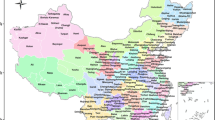Abstract
The great population advance and the unrestrained consumption of natural resources have contributed to the accelerated deterioration of the physical, chemical, and biological characteristics of the aquatic system. In general, Brazilian hydrographic basins are in environmental degradation, which may also compromise human life in the near future, often a consequence of inadequate public policies. Therefore, this research aims to get to know and study the main sustainability indicators used in the environmental management of the Hydrographic Basins of the Piracicaba, Capivari, and Jundiaí rivers, in order to analyze the existing environmental impacts. Considering the importance of the water resource and all the problems involving the critical issue of water in Brazil, it is emphasized that sustainability indicators are important for the management of basins and sub-basins, as they serve as a basis for the formulation of action plans to propose improvements and implement solutions. Thus, the results obtained from the information and data collected can be used to understand the indicators related to water resources in the municipalities of the Metropolitan Region of Campinas, in order to alleviate water scarcity and related problems.
Access this chapter
Tax calculation will be finalised at checkout
Purchases are for personal use only
Similar content being viewed by others
References
Soares, A.B., Silva Filho, J.C.L., da, Abreu MCS de, Soares, F.A.: Revisando a estruturação do modelo DPSIR como base para um sistema de apoio à decisão para a sustentabilidade de bacias hidrográficas. Revista em Agronegócios e Meio Ambiente, 4(3), 521–545 (2011)
Lelis, T.A., Calijuri, M.L., Santiago, A.F., de Lima, D.C., Rocha, E.O.: Análise de sensibilidade e calibração do modelo SWAT aplicado em bacia hidrográfica da região sudeste do Brasil. Rev. Bras. Ciênc. Solo 36(2), 623–634 (2012). https://doi.org/10.1590/S0100-06832012000200031
Rodrigues, A.: Gestão Hídrica governança dos bens comuns Gestão Hídrica (2011). https://on-dasbrasil.org/wp-content/uploads/2020/02/livro-Gest%C3%A3o-H%C3%ADdrica.pdf. Accessed 06 Apr 2021
Emplasa Região Metropolitana de Campinas (RMC). GIP/CDI (2019). https://em-plasa.sp.gov.br/RMC#:~:text=A%20Regi%C3%A3o%20Metropolitana%20de%20Campinas,Santo%20Ant%C3%B4nio%20de%20Posse%2C%20Sumar%C3%A9%2C. Accessed 14 May 2021
PDUI. Plano de Desenvolvimento Urbano Integrado da Região Metropolitana de Campinas (2017). https://www.pdui.sp.gov.br/rmc/?page_id=56. Accessed 20 May 2021
Comitês, P.C.J.: Relatório de Situação dos Recursos Hídricos: versão simplificada (Ano Base 2018). Piracicaba: Fundação Agência das Bacias PCJ (2019)
Comitês, P.C.J.: Relatório Síntese: Plano de Recursos Hídricos das Bacias Hidrográficas dos rios Piracicaba, Capivari e Jundiaí, 2020 a 2035. Porto Alegre: Consórcio Profill-Rhama PCJ (2020a)
ANA. Agência Nacional de Águas e Saneamento Básico. O Comitê de Bacia Hidrográfica: o que é e o que faz? Agência Nacional de Águas e Saneamento Básico. Cadernos de capacitação em recursos hídricos Brasília: SAG, 64p (2011). https://ar-quivos.ana.gov.br/institucional/sge/CEDOC/Catalogo/2012/CadernosDeCapacitacao1.pdf. Accessed 05 May 2021
Cobrape. Companhia Brasileira de Projetos e Empreendimentos Plano das Bacias Hidrográficas dos Rios Piracicaba, Capivari e Jundiaí 2010 a 2020. Relatório Síntese. São Paulo: Cobrape: Neoband Soluções Gráficas (2011)
Comitês, P.C.J.: Sumário Executivo: Plano de Recursos Hídricos das Bacias Hidrográficas dos rios Piracicaba, Capivari e Jundiaí, 2020 a 2035. Porto Alegre: Consórcio Profill-Rhama PCJ (2020b)
Brasil. Lei nº 9.433 de 08 de janeiro de 1997 (1997). http://www.planalto.gov.br/ccivil_03/leis/l9433.htm#:~:text=LEI%20N%C2%BA%209.433%2C%20DE%208%20DE%20JANEIRO%20DE%201997.&text=Institui%20a%20Pol%C3%ADtica%20Nacional%20de,o%20inciso%20XIX%20do%20art.&text=1%C2%BA%20da%20Lei%20n%C2%BA%208.001,28%20de%20dezembro%20de%201989. Accessed 23 Feb 2021
Demajorovic, J., Caruso, C., Jacobi, P.R.: Cobrança do uso da água e comportamento dos usuários industriais na bacia hidrográfica do Piracicaba, Capivari e Jundiaí. Revista de Administração Pública, 49(5): 1193–1214 (2015). https://www.scielo.br/scielo.php?script=sci_arttext&pid=S0034-76122015000501193&lang=en. Accessed 03 Feb 2021
ANA. Agência Nacional das Águas e Saneamento Básico. Comitês de bacias hidrográficas (2015). http://www.cbh.gov.br/#not-estaduais. Accessed 02 June 2021
Instituto Trata Brasil. Perdas de água 2019 (SNIS 2017): Desafios para Disponibilidade Hídrica e Avanço da Eficiência do Saneamento Básico (2019). http://www.tratabrasil.org.br/images/estudos/itb/Tabela_das_100_cidades.pdf. Accessed 10 Apr 2021
Instituto Trata Brasil, Perdas de Água 2018 (SNIS 2016): Desafios para Disponibilidade Hídrica e Avanço da Eficiência do Saneamento Básico. São Paulo: GO Associados (2018). http://www.tratabrasil.org.br/images/estudos/itb/perdas-2018/estudo-completo.pdf. Accessed 10 Apr 2021
SNIS. Sistema Nacional de Informação sobre Saneamento. Série Histórica – (ano-base 2019) (2019). http://app4.mdr.gov.br/serieHistorica. Accessed 10 Apr 2021
Silva, A.A.: Indicadores para avaliação de efeitos de intervenções de saneamento básico: a questão da sustentabilidade, 138 f. Universidade de São Paulo, Dissertação (Mestrado) Faculdade de Saúde Pública, São Paulo (2015)
Author information
Authors and Affiliations
Corresponding author
Editor information
Editors and Affiliations
Rights and permissions
Copyright information
© 2023 The Author(s), under exclusive license to Springer Nature Switzerland AG
About this paper
Cite this paper
Zancanela, D.A.I., Ferreira, D.H.L., do Carmo, L.A.G., Silva, M.L.D., Sugahara, C.R. (2023). Study of Sustainability Indicators for Environmental Management in Hydrographic Basins. In: Iano, Y., Saotome, O., Kemper Vásquez, G.L., Cotrim Pezzuto, C., Arthur, R., Gomes de Oliveira, G. (eds) Proceedings of the 7th Brazilian Technology Symposium (BTSym’21). BTSym 2021. Smart Innovation, Systems and Technologies, vol 207. Springer, Cham. https://doi.org/10.1007/978-3-031-04435-9_5
Download citation
DOI: https://doi.org/10.1007/978-3-031-04435-9_5
Published:
Publisher Name: Springer, Cham
Print ISBN: 978-3-031-04434-2
Online ISBN: 978-3-031-04435-9
eBook Packages: EngineeringEngineering (R0)




